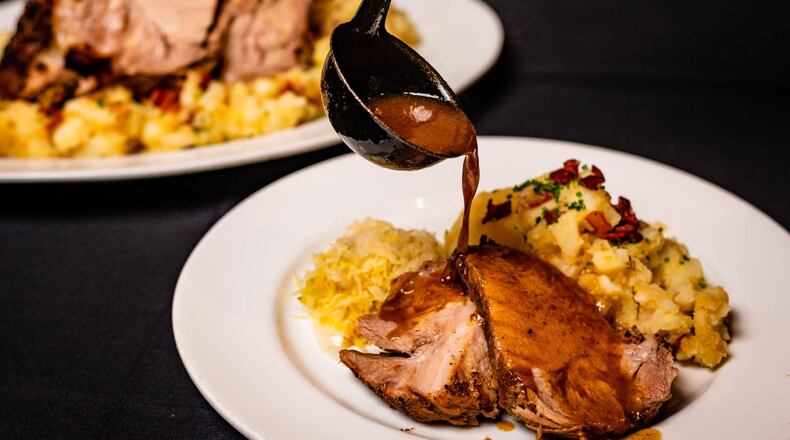Our rainy February has many of us craving the sense of well-being that comes from gently bubbling dishes perfuming our kitchens for hours at a time.
Braised meals, especially braised meats, warm us inside while providing dishes with intense, concentrated flavors. Start them in the middle of the day and let them cook unattended through the afternoon. They’re ready for dinner that night, or even better, let them cool and then refrigerate them for a day or two.
“Braising is that rare technique that gives you food that tastes better after it’s been chilled and reheated.”
That's a quote from Michael Ruhlman, author of "How to Braise" (Little, Brown and Company, $25). If you have time to braise your meat the day before you want to eat it, the fat will separate out and congeal on the surface, where it's easy to remove.
And braised dishes are perfect for dinner parties. The main course, and frequently its accompanying vegetables, is all done ahead of time, just waiting for reheating.
Braising by definition is the process of searing food in oil or by a dry heat method such as grilling, and then cooking it in liquid. The searing adds flavor; cooking in liquid tenderizes the meat.
Ruhlman describes braising as metamorphosis. “When you braise, you begin with a tough, often inexpensive cut of meat, and through your care and knowledge as a cook, you turn it into something tender and succulent and exquisite.”
And this works for vegetables like artichokes and leeks just as well as it does lamb shanks and brisket.
Here are a few tips for braises from Anthony Puharich and Libby Travers from "The Ultimate Companion to Meat" (The Countryman Press, $45):
• Gently season the ingredients to begin with, but don’t season the dish until the very end, after the sauce has reduced, or you risk the whole dish becoming too salty.
• When using wine or beer in your cooking liquid, remember you are going to cook out the alcohol and many of the intricate flavors.
• Use a cartouche, a round of parchment paper cut just bigger than the diameter of your casserole dish. Crumple and wet it before laying it on top of the braise. This helps keep the liquid from evaporating too quickly and prevents a skin from forming on top of the sauce. Some recipes will call for using a cartouche with no lid; others add a lid as extra protection for the braise.
Try these recipes and people will say, “It smells good in here” when they walk in the door.
RECIPES
Never attempt a braised meat recipe on a day when you’re facing a deadline. As Anthony Puharich and Libby Travers write in “The Ultimate Companion to Meat” (The Countryman Press, $45), “There is no hurrying a braise. This is a good reason to do this a day in advance, giving the meat time to tell you it is ready.”
Beef Daube
A daube is a classic dish of inexpensive beef braised with wine, vegetables and seasonings. Anthony Puharich and Libby Travers tweak the recipe by using a flat iron steak instead of the chuck you might expect. They had lots of umami by including anchovies and olives in the final dish and add a small amount of vinegar to cut through the richness.
Consider this as an option the next time you’re thinking “beef stew” for dinner. Just prepare ahead as you’ll marinate the beef overnight.
— Adapted from a recipe in “The Ultimate Companion to Meat” by Anthony Puharich and Libby Travers (The Countryman Press, $45).
Brad Parker’s Schweinebrate
This traditional German dish is an Oktoberfest specialty, pork shoulder that’s cooked long and slow in a rich sauce. Brad Parker, executive chef of Dantanna’s Buckhead, adapted his recipe from the traditional, and suggests using a Bavarian marzen beer in the braising liquid. You want to use a beer with a nice balance of malt to hop. The alcohol will cook out, but the flavor remains and the resulting gravy is delicious.
Parker suggests accompanying this braised pork with sauerkraut and German potato salad.
— Adapted from a recipe provided by executive chef Brad Parker of Dantanna’s Buckhead.
Butter-Braised Radishes with English Peas
These radishes would be a bright accompaniment to any braised meat you serve. The recipe follows the rules of a braise — searing the radishes in butter, then covering them so they’ll cook in the liquid they produce — but you want to cook them just until tender, not falling apart.
You’ll find farmers bringing beautiful radishes to your local farmers market, including the pretty French breakfast radishes pictured here. But no fancy radishes are required. If using regular red radishes, cut them in half or quarter them.
— Adapted from a recipe in “How to Braise” by Michael Ruhlman (Little, Brown and Company, $25).
Read more stories like this by liking Atlanta Restaurant Scene on Facebook, following @ATLDiningNews on Twitter and @ajcdining on Instagram.
About the Author
Keep Reading
The Latest
Featured





